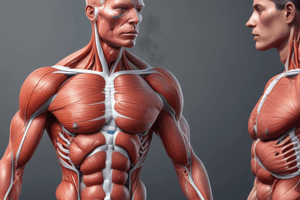Podcast
Questions and Answers
What is the primary function of the clavipectoral fascia in the axilla?
What is the primary function of the clavipectoral fascia in the axilla?
- To protect the subclavius muscle from injury
- To provide a pathway for neurovascular structures
- To support the shoulder joint
- To connect the clavicle to the axillary floor (correct)
Which structure passes directly through the pectoralis minor muscle?
Which structure passes directly through the pectoralis minor muscle?
- Lateral thoracic artery
- Thoraco-acromial artery
- Cephalic vein
- Medial pectoral nerve (correct)
Which of the following structures does NOT pass between the subclavius and pectoralis minor muscles?
Which of the following structures does NOT pass between the subclavius and pectoralis minor muscles?
- Lateral pectoral nerve
- Cephalic vein
- Thoraco-acromial artery
- Lateral thoracic artery (correct)
Which muscle is directly enclosed by the clavipectoral fascia?
Which muscle is directly enclosed by the clavipectoral fascia?
What is the primary role of the thoraco-acromial artery in the axilla?
What is the primary role of the thoraco-acromial artery in the axilla?
What is the primary function of the axilla in relation to the upper limb?
What is the primary function of the axilla in relation to the upper limb?
Which bone contributes to the medial margin of the axillary inlet?
Which bone contributes to the medial margin of the axillary inlet?
Which of the following is NOT considered a wall of the axilla?
Which of the following is NOT considered a wall of the axilla?
Which nerve is associated with the axilla and primarily innervates the deltoid and teres minor muscles?
Which nerve is associated with the axilla and primarily innervates the deltoid and teres minor muscles?
What type of anatomical structure does the axilla represent?
What type of anatomical structure does the axilla represent?
Which of the following muscles is NOT typically associated with the axilla?
Which of the following muscles is NOT typically associated with the axilla?
Which structure marks the base of the axilla?
Which structure marks the base of the axilla?
What forms the posterior margin of the axillary inlet?
What forms the posterior margin of the axillary inlet?
Which major vessels and nerves pass from the neck to the axilla?
Which major vessels and nerves pass from the neck to the axilla?
What structures form the floor of the axilla?
What structures form the floor of the axilla?
Which muscles contribute to the anterior axillary fold?
Which muscles contribute to the anterior axillary fold?
Which muscles contribute to the posterior axillary fold?
Which muscles contribute to the posterior axillary fold?
What is the role of the axillary inlet in relation to the axilla?
What is the role of the axillary inlet in relation to the axilla?
Which components are included in the anterior wall of the axilla?
Which components are included in the anterior wall of the axilla?
What is the significance of the axillary inlet?
What is the significance of the axillary inlet?
How is the floor of the axilla defined in terms of its structure?
How is the floor of the axilla defined in terms of its structure?
Flashcards are hidden until you start studying
Study Notes
Axilla Anatomy
- The axilla is a pyramidal space located between the neck and the arm.
- Apex: The apex is formed by the lateral border of rib I, the posterior surface of the clavicle, and the superior border of the scapula.
- Base: The base is formed by skin and fascia, extending between the anterior and posterior axillary folds. The anterior axillary fold is formed by the lower margin of the pectoralis major muscle. The posterior axillary fold is formed by the teres major and latissimus dorsi muscles.
- Walls: The walls of the axilla are:
- Anterior wall: Skin, superficial fascia, deep fascia, pectoralis major muscle, pectoralis minor muscle, subclavius muscle.
- Posterior wall: Skin, superficial fascia, deep fascia, subscapularis muscle, teres major muscle, latissimus dorsi muscle.
- Medial wall: Skin, superficial fascia, deep fascia, serratus anterior muscle.
- Lateral wall: Skin, superficial fascia, deep fascia, humerus.
Contents of the Axilla
- The axilla contains major vessels and nerves:
- Subclavian artery: Supplies the upper limb.
- Axillary vein: Drains the upper limb.
- Trunks of the brachial plexus: Provide motor and sensory innervation to the upper limb.
- The axilla also contains lymph nodes and fat.
Clavipectoral Fascia
- The clavipectoral fascia is a thick sheet of connective tissue that connects the clavicle to the floor of the axilla. It encloses the subclavius and pectoralis minor muscles and fills the gap between them.
- Structures that pass through the clavipectoral fascia:
- Cephalic vein
- Thoraco-acromial artery
- Lateral pectoral nerve
- Structures that leave the axilla through the clavipectoral fascia:
- Lateral thoracic artery passes inferior to the pectoralis minor muscle.
- Medial pectoral nerve penetrates directly through the pectoralis minor muscle.
Studying That Suits You
Use AI to generate personalized quizzes and flashcards to suit your learning preferences.




